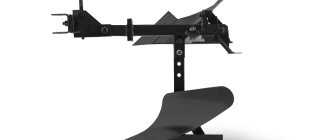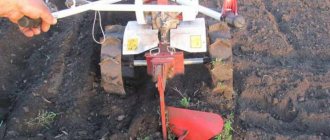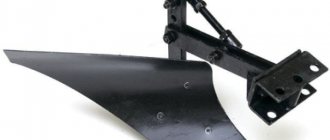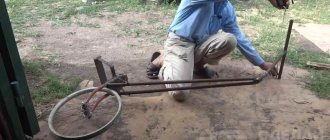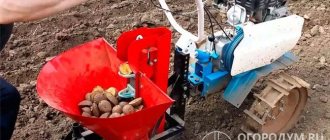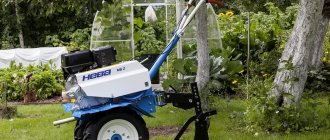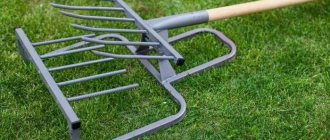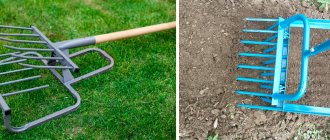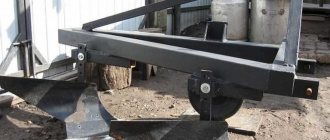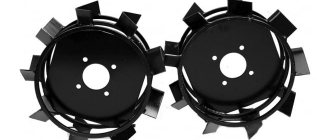The walk-behind tractor attracts small agricultural workers and owners of personal plots with its versatility and versatility. And, of course, not the least popular in the list of jobs he can do is plowing the plot. At first glance, there is no wisdom in this process, but this judgment is more than erroneous. Of course, if you set a goal, not only to do a high-quality job, but also to ensure long and trouble-free operation of the equipment.
Plowing the site
It’s not difficult to figure out how to plow with a walk-behind tractor and a plow.
To do this, you need to roll out the device to the place where the land is plowed and along the first row, where loosening will take place, pull a cord that you can use to guide it - the plow pulls to the right, and it is quite difficult to make the first row level without auxiliary means. The handle of the equipment should be turned to the left in order to walk across an area of land that has not yet been plowed. Before starting the main plowing, it is necessary to carry out control plowing of the soil - walking to the opposite end of the site at low speed.
This is necessary to check whether the tiller is adjusted correctly and whether the furrow depth is sufficient (it should be 15–20 cm). We place the right lug in the row-crop furrow, engage first gear, tilt the device to the right and begin to move.
Having completed the first control pass, we turn the device 180 ° so that the right wheel of the walk-behind tractor is on the opposite side to the already plowed row, and move in the opposite direction. After the second pass, we evaluate the depth of the furrow. If the depth is not sufficient or the furrow is too deep, the plow must be adjusted again.
When plowing the area, you need to make sure that the right lug does not extend beyond the furrow and that the plow stand is perpendicular to the surface of the ground. The ridge of each subsequent furrow should not be far from the previous one (the distance between the ridges is up to 10 cm).
It is also important to ensure that the furrow does not lie on top of the previous furrow as a heap of earth. To do this, the right wheel must move in the middle
If you figure out how to properly plow a plow on a walk-behind tractor and correctly adjust it, then the device should move smoothly, without jerking or pulling to the side.
Over time, when you are sure that the furrows are even, the speed can be increased so that the surface of the earth is level and the plowing itself goes faster.
You need to plow the soil with a walk-behind tractor slowly, you cannot push the device. If the engine overheats, which often happens, plowing must be stopped for a while.
Did you know? The fertile layer (humus) cannot be restored. As a result of plowing, the oxygen level in the deep layers of the soil increases, causing humus to mineralize. This is the reason that in the first years, plowed soils produce large yields. However, it is the process of mineralization of the fertile layer that leads to a reduction in its quantity, which can have bad consequences for humanity.
Thus, we found out that it is better to use medium and heavy walk-behind tractors for hanging a plow and plowing the ground with it. The plow is attached to the minitractor using hitches, after which it must be adjusted (depth, handle, plowing plane level). Correct adjustment is the key to effective plowing. When plowing the area, you need to monitor the depth of the furrows, the engine temperature, and the position of the walk-behind tractor wheels.
Plow hitch
This operation is quite complicated - it is best performed with an assistant. To hang the plow, the walk-behind tractor is slightly raised above the ground. To do this, it is driven onto some stands with a height of at least 15 cm. It is with this procedure that preparation for the operation of small-scale mechanization equipment intended for plowing land, of any brand, should begin. Including such a popular one as, for example, the Neva walk-behind tractor. How to properly plow the land using this brand of equipment will be discussed below.
The hitch itself is made according to the instructions of the walk-behind tractor and plow manufacturers. When performing this operation, you need to ensure that the entire surface of the edge of the plowshare touches the ground. The plow stand should be positioned strictly vertically, and the beam should be positioned horizontally.
Of course, the equipment should also be adjusted according to the track width. To do this, you need to pay attention to how the plow share is located. Its right edge should be in line with the inner edge of the right wheel. In this case, the plow will cut the soil evenly and roll it off easily. The walk-behind tractor itself will go easier.
What attachments does the walk-behind tractor work with?
Any experienced farmer knows that with the help of a walk-behind tractor, cultivator or other motorized equipment, almost all agricultural work can be mechanized, from cultivating the land to prepare it for sowing and ending with transporting the harvested crop. Motor units have become universal due to the possibility of using a variety of attachments. For example, for cultivating plowed land and cultivating virgin lands, not only moldboard and other plows were created, but also:
- harrows;
- hillers;
- rotary cutters;
- flat cutters-weeders.
Harrows are used to plow virgin soil, as well as for pre-sowing or post-harvest loosening of arable soil to a depth of 7-14 cm. Using harrowing with a walk-behind tractor or cultivator, the surface is leveled, moisture is covered, and weeds are destroyed. The working parts of such agricultural implements are metal teeth or spherical disks. In this video you can clearly see how to properly plow with a walk-behind tractor and a homemade harrow.
Using a hiller, you can hill up potatoes, cut furrows for sowing seeds, fill in planting material, and also sprinkle weeds directly in the area of the rows. Hilling devices come in single-row and double-row, with fixed and adjustable working widths, distinguishable both by their design and their efficiency. Here is a video of how the Neva MB2 walk-behind tractor performs processing with a mounted two-row hiller-weeder.
With a rotary cutter you can plow virgin soil, carry out pre-sowing and basic cultivation of plowed land. This agricultural implement allows you to mill, cultivate the land and qualitatively prepare it for sowing. It is capable of not only plowing the soil, but also crumbling large layers, mixing with fertilizer, crushing stubble particles, and leveling the sown area. Rotators for plowing come in different types, depending on the number of cutting elements. This video shows how to actually plow a walk-behind tractor with a cutter installed on it.
A flat weeding cutter helps to trim weeds, split and cut grooves without turning the formation, plow and crush the soil. Flat cutters come in all possible working widths and processing depths, which allows you to choose them for specific processing conditions of agricultural plots and crops. This video shows how to carry out processing with a mounted flat cutter in practice using the example of a Dnepr walk-behind tractor.
In addition to the listed removable tools designed to plow virgin soil and cultivate arable land, rakes, wood splitters, seeders, shredders, cultivators, rotary and segment mowers, shovels, sprayers, sweeping brushes, snow blowers, etc. are used with the motorized unit. Having a basic set of mounted agricultural implements, you can use a walk-behind tractor or a powerful cultivator to perform all kinds of economic tasks, in particular, pre-sowing plowing, sowing and planting crops, applying fertilizers, inter-row cultivation of crops, harvesting root crops, and seasonal harvesting of green fodder.
Important clarifications
Plowing with a walk-behind tractor occurs vertically; when it begins to deviate, the farmer, using his own strength, redirects it in the right direction and then monitors the correct movement of the tool. To make this task easier, the nuts in the adjustment groove are loosened and tightened again when finished.
Walk-behind tractors are often used for hilling potatoes , for which they attach another attachment - a hiller. It cuts the ground to the same depth as a plow. There are two types: regular and disk. More convenient to use is the disc-shaped one, but it is significantly more expensive.
The walk-behind tractor is known as a convenient tool for harvesting. Instead of a hiller or plow, an object is hung, which is a mixture of weeding paws and a lattice. His job is that he lifts the ground, takes root crops and pours the soil back so that the harvested crop remains on the surface.
Walk-behind tractor for plowing land
Experienced farmers are well aware of how important it is to carry out high-quality cultivation of the land before planting, as well as in the fall. Yield largely depends on this
If earlier you had to spend whole days on such work, now you can use a walk-behind tractor that will cope with the task in an hour. When choosing a high-quality and productive device, you can process in two hours the area that would take a whole day with manual plowing.
When choosing an assistant to work on the farm, many people wonder whether it is possible to cultivate the land with a Neva walk-behind tractor or another model, or whether a walk-behind cultivator is better. In fact, there are no significant differences between these types of technology. Many farmers use both one and the second name to refer to conventional walk-behind tractors.
Tillage
The advantage of the cultivator is the ability to dig the garden in parts, in separate beds before sowing.
You can dig in two ways, moving in a zigzag (rows going back and forth) or in a circle (starting from the center and spiraling into a larger circle). For a rectangular garden, the first method is more convenient per square second.
The processing procedure is as follows.
- Set the required number of cutters.
- Remove the wheels.
- Start the engine and warm it up.
- Press the clutch lever.
- Follow the cultivator, directing its movement.
- Make sure there are no untreated areas.
Proper plowing of the land with a walk-behind tractor
Before plowing, wheels with a diameter of 50−60 cm and a width of 18−20 cm are hung
It is important to comply with these parameters; if the wheels are too narrow, there is a possibility that the tool will swing from side to side. An insufficiently large diameter will create a small distance between the soil and the gearbox
If the rim is solid, the likelihood of soil collecting in the lug ribs increases.
You will need a partner to hang the equipment. It will help to lift the equipment and place it on stands, to a recommended height of 15-20 cm. In this case, the edge of the ploughshare should touch the ground. The plow stand is positioned vertically, and the beam is installed in a horizontal position. The right edge is installed in line with the inner edge of the right wheel. This ensures even cutting of the soil, easy falling off and smooth running of the walk-behind tractor. Before carrying out operations, you should consult the manufacturer's instructions.
Soil preparation
A cord is stretched along the ground, which serves as a guide for further movement. It is usually installed on the first row. These rules help inexperienced plowmen maintain a landmark, since the plow leads to the side. On the second row the cord is removed. As a rule, a person who has already done similar types of work has no problems maintaining the required distances and making all the rows even.
Working with land
After preliminary preparation, plowing begins. For fewer unnecessary movements, the walk-behind tractor goes along the side that is larger. This allows you to make fewer turns, which saves both the worker’s effort and the time spent redefining the direction of the block. Handle swivels to the left for ease of movement on unplowed ground
It is important to maintain a moderate pace of movement of the block to prevent the motor from heating up. In case of overheating, operation is suspended until the unit cools down
It is also not recommended to push the plow.
Each field is unique and has different soil hardness. The normal quality of the soil is looseness, in which the soil can easily be pierced with a metal stick to a depth of 50 cm. Hard soil makes it difficult for the plowing machine to move and negatively affects the serviceability and further performance of the tool. In this case, the soil is moistened with ordinary water or special solutions, and the plot is passed through twice. The first is preparatory, and the second is used for plowing to full depth. In some cases, you should consolidate the result and go through it a third time.
Wheel installation
So, let's see how to plow the ground correctly with a walk-behind tractor. Before starting the operation, the equipment, of course, needs to be prepared. Wheels are attached to the walk-behind tractor, then the plow is installed. As for the first ones, their diameter should be at least 50-60 cm, and their width – 18-20 cm. Otherwise, high-quality plowing will not work. If the wheels are too narrow, the walk-behind tractor will start to shake from side to side. If their diameter is small, it will be impossible to provide a sufficient distance between the soil surface and the gearbox.
When choosing wheels for a walk-behind tractor, you should also pay attention to the rim. It is desirable that it is not continuous. Otherwise, earth will accumulate between the lug ribs.
Advantages and disadvantages of mechanical plowing of the site
It is quite clear that during the operation of technical devices, energy and time are significantly saved, so the level of productivity of workers in the agronomic industry increases literally several times. It is also very encouraging that along with plowing the garden with a walk-behind tractor, you can carry out other useful procedures, such as loosening the soil or adding useful substances and fertilizers to the soil. Another advantage of using technological development is the uniformity of tillage, improvement of soil condition and its saturation with oxygen. During the cultivation process, there is a decrease in the number of weeds and harmful insects, because during plowing, pests are “thrown out” to the surface, where they become prey for birds. As evidenced by the results of numerous studies, after cultivating the land with a walk-behind tractor, the soil demonstrates the highest yields. With all this, there are some not particularly pleasant features associated with this procedure. We are talking about contraindications for plowing an area with weeds and those that have a deep root system. Constant cultivation is also a kind of stress for the soil, so it is necessary to periodically “feed” it with fertilizers and other things.
How to prepare virgin soil for a garden, how to treat and fertilize the soil
Virgin land is an uncultivated plot of land that has not been plowed for more than 20 years. Such soil is rested and maximally full of nutrients necessary for plants. However, summer residents are more concerned about the possibility of using such a plot for a vegetable garden.
The better way to process virgin soil
It is quite possible to turn virgin soil into fertile soil for growing garden crops. The first stage is plowing the land. It is best to use a tractor, but this is quite expensive and is not possible in small areas.
It is possible to process virgin soil with a walk-behind tractor, but its power may not be enough for areas that are too hard. In this case, the procedure must be repeated several times (first superficially, then deeper), or in a wet state, so that the equipment does not slip. The advantage of using any technique is less labor costs and faster results.
Processing small areas is carried out manually only with a shovel, but this is quite hard work. Mechanical devices and hand plows are not used for plowing virgin soil, since the strength of one person is not enough.
If digging with machinery is not possible, the soil is dug up manually with a shovel, lifting it to a depth of 15 cm. The lumps are not broken, but left to dry, after which the turf is shaken off the soil, helping with a hand ripper. Plant rhizomes are placed in a compost pit to rot.
How to prepare the soil for planting vegetables
After the first processing of virgin soil, you cannot immediately begin cultivation. It is necessary to further prepare the land. If the soil was processed using machinery, then weeds are not selected from it, as with manual digging, but are plowed up along with the soil.
After plowing with a walk-behind tractor or
To improve the structure of the soil and saturate it with useful microelements, green manure plants (mustard, lupine, oats, rye, alfalfa) are planted. When the greenery grows, it is mowed and additional digging is carried out using machinery or manually.
Winter crops are planted in winter. In early spring, after the snow melts, the third plowing is carried out and the plot is planted with garden crops for the first time.
After manual digging
When cultivating the land manually, you can use the previous method, but more often they do it differently. The land freed from turf is treated with herbicides to kill weeds. Then sprinkle with peat, humus or sawdust and dig, mixing everything.
A week later, the soil is fertilized with complex mineral fertilizers: potassium sulfate, ammonium nitrate, nitrophoska, superphosphate and dug up a second time. The land becomes suitable for use as a vegetable garden.
What to do if you need to process a large area manually
When processing a large area of virgin soil by hand, a popular method is dividing the area into small segments, which are covered with a double layer of dense material at least 5 cm thick. You can use cardboard, straw, black film or spandbond, and press down with bricks.
The ground overgrown with grass is left covered until autumn, when the greenery under such dense mulch has time to rot and rot. Thanks to humus, many earthworms will appear, which will loosen the soil, and the soil will be easier to work with. The disadvantage of this method is that the beds are ready for planting only at the beginning of the next season.
It is possible to prepare the land using inverted turf. Areas overgrown with grass are dug up manually with a shovel. Potatoes are planted in the resulting holes, which are covered with dug up turf, turning it over with the grass part down.
The grass in the ground rots, thereby fertilizing the potatoes and promoting their growth. This method allows you to harvest the crop the first time you plant it. But the timing of planting potatoes must be observed.
If space for beds is needed for urgent planting, and it is not possible to wait until next year, you can use the option of bulk beds. The prepared fertile soil is poured directly onto virgin soil, and the rows are dug up and treated with targeted herbicides. Plants with a shallow root system (zucchini, cucumbers) can be planted in them.
Recommendations
To ensure that working with a walk-behind tractor is easy and soil cultivation is effective, you must follow a number of simple recommendations.
- It is better to cultivate plots up to 6 acres in size using cultivators. But if you decide to use a walk-behind tractor, then instead of a plow you should use saber-shaped or claw cutters.
- It is recommended to use a mounted plow when plowing fields larger than 1 hectare. However, it is also better to process the edges of areas and places with complex geometry using cutters.
- During operation, it is necessary to carefully monitor the condition of the equipment and prevent oil leakage from the transmission. Otherwise, harmful liquid will enter the treated soil and cause partial contamination.
- When plowing virgin lands, as well as when cultivating rocky and clayey soils, it is necessary to use weighting agents. Otherwise, there is a high risk that the walk-behind tractor will start jumping on the virgin soil and deep plowing will require a lot of effort.
- When using cutters, it is recommended to equip their ends with protective discs. This will reduce the likelihood of cultivating adjacent lands and will allow plowing strictly along the boundaries of the site.
- To reduce the strain on hearing, you should use special headphones or earplugs, and to partially neutralize vibration, you should wear mittens. In addition, when plowing, it is necessary to move on the leeward side, which will minimize the harmful effects of exhaust gases. If you have to plow in a large greenhouse, then you should ensure good ventilation of the room. To do this, it is necessary to open all windows and doors, and also periodically turn off the engine and ventilate the greenhouse.
- Filling the fuel tank, as well as changing the engine oil, should only be done with the engine turned off. In this case, it is advisable to pass the fuel through a funnel with a special filter.
- Operating the walk-behind tractor near an open fire and wiping it with a rag soaked in gasoline is strictly prohibited.
Plowing a plot with a walk-behind tractor helps to significantly facilitate the tillage process, improves the overall condition of the soil, increases productivity and significantly reduces the time of work.
See the video below about plowing the land with a walk-behind tractor.
Kinds
With the help of walk-behind tractors, you can perform different types of agricultural work. Depending on the size of the area being processed and the demand for equipment in different fields of activity, equipment is purchased in light, medium and heavy classes.
Lungs
This mini-equipment is often called a motor cultivator. Its power does not exceed 4 and a half horsepower, which is why it costs less than medium and large units. The cost of the lightweight model is from 12 to 22 thousand rubles. The advantages include the light weight of the monoblock and the accessibility of processing inconvenient areas due to the small grip of the cutter.
The downside is the rapid overheating of the low-power motor, which means that you will have to work with such equipment for a short time. In addition, the depth of the excavated soil is less than that of a heavy walk-behind tractor. In addition, light equipment does not have mounts for additional equipment.
Average
This vehicle has rear-wheel drive. Engine power – 5-12 horsepower. The device is capable of processing an area of half a hectare. The walk-behind tractor weighs from 50 to 70 kilograms, its cost is 30-40 thousand rubles. Most walk-behind tractors in this category can be used to mount a plow and other equipment.
This technique has 2 gears and is equipped with a front headlight. Compared to a heavy walk-behind tractor, a medium walk-behind tractor is more maneuverable, but its plowing depth does not exceed 12 cm. And this is unacceptable for planting some plants.
How to plow with a cultivator correctly?
Regardless of which cultivator you choose, plowing the land must follow certain rules. Suppose a Carver cultivator is used for work, first the owner runs the equipment, inspects all the parts and checks their performance. Only then does he begin the actual plowing.
Before starting work you need:
- Prepare the soil, remove stones and large branches.
- Install the plowing attachment.
- Inspect the cultivator mount and set the height of its handle.
When plowing with a motorized cultivator, you need to wear closed shoes and pants; your feet should be kept at a certain distance from the equipment. Do not use the forward and reverse handles at the same time; one of them should be released.
Plowing the soil with a motor cultivator should take place on slightly moist soil and requires compliance with some recommendations.
- A rectangular vegetable garden is cultivated “in a circle.”
- The square plot is plowed in a zigzag manner.
- You can plow in sections to avoid disturbing plants or trees.
- Depending on the type of soil and the complexity of working on it, the speed and depth of plowing varies.
- On the ground with small stones, work at minimum speed.
- If the area narrows, you can reduce the width of the strip by removing the outer cutters.
- When plowing the beds, free areas are left at the end of each of them, which you can go out to to move between the rows.
You don’t need to push the equipment hard in front of you, just point it in the right direction. If the cultivator stalls a little, you can rock it to continue moving. You should not follow the machine, trampling the plowed soil. Just turn the handle and walk along.
Tilling the land with a cultivator provides for smooth and easy work on the site. If the equipment is buried in the ground, it is necessary to swap the cutters or adjust the position of the wheels.
After all work is completed, the metal parts of the cultivator are wiped with a rag, the cutters are washed and wiped dry.
You can also watch a video on how to properly till the soil.
Number of blocks: 8 | Total number of characters: 9389 Number of donors used: 4 Information on each donor:
Preparatory activities
We’ll talk about how to plow the ground with a walk-behind tractor a little lower. First, let's find out what other preparatory activities, in addition to hanging the wheels and plow, need to be done.
Before starting the operation of loosening the soil, it is worth stretching an orientation cord along the first row of the plot. Experienced plowmen may well skip this step. Beginners should definitely perform this operation. The fact is that during the plowing process, any plow moves slightly to the right. And therefore it is very difficult to make a row perfectly even. The cord will help you not to deviate from the “course”.
Starting from the second, all rows can be done without the use of additional guides, since the wheel of the walk-behind tractor will follow the furrow.
Reasons for deep cutting cutters
In photo 10 you can see that the walk-behind tractor has stopped moving forward, the cutters have gone very deep into the layer of earth. To put it simply, the walk-behind tractor is buried in the ground! Why might this happen? Below are the main reasons why a walk-behind tractor breaks down, as well as ways to eliminate them.
1. The soil on the site is very moist and clogs the knives; you need to wait until the soil dries.
2. The coulter is deeply buried in the soil; it is necessary to adjust the coulter.
3. Insufficient speed, it is necessary to set the gas regulator to the maximum value and check the speed mode (select a higher gear for the walk-behind tractor).
4. The soil in the area is highly compacted, so it is necessary to cultivate the area in two times:
- Primary tillage with minimal coulter depth.
- Final tillage is carried out when the coulter is buried to the required depth.
5. The cutters of the walk-behind tractor are installed incorrectly; check that the cutters are installed correctly.
These are the most common reasons why the tillers of a walk-behind tractor go very deep into the ground and the walk-behind tractor stands still.
